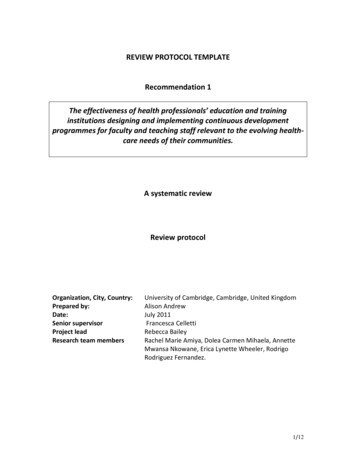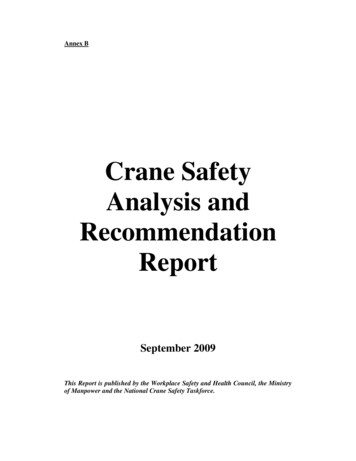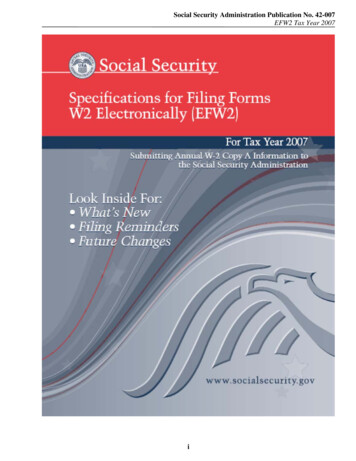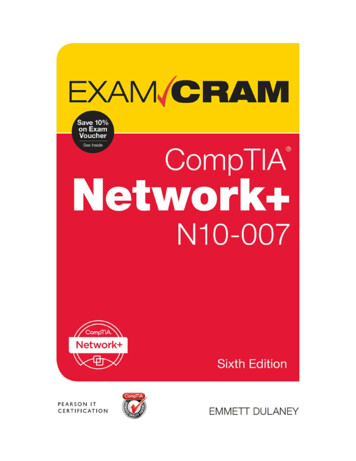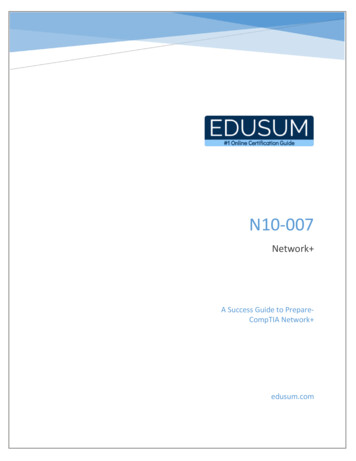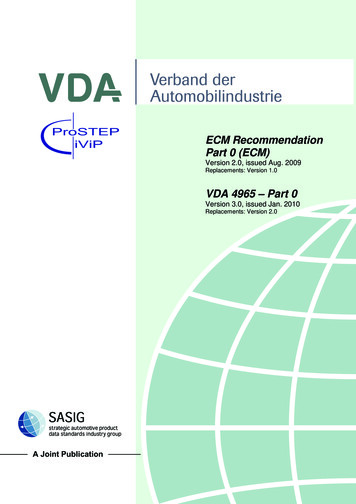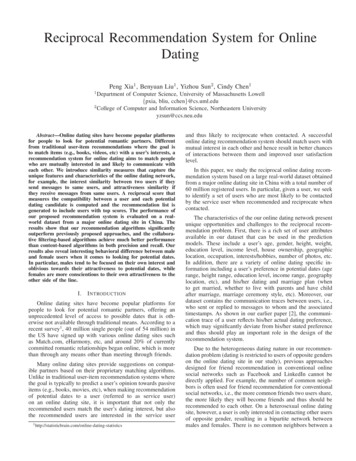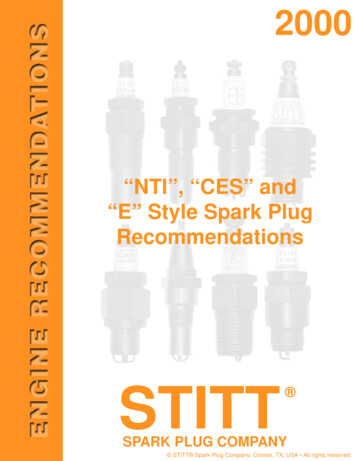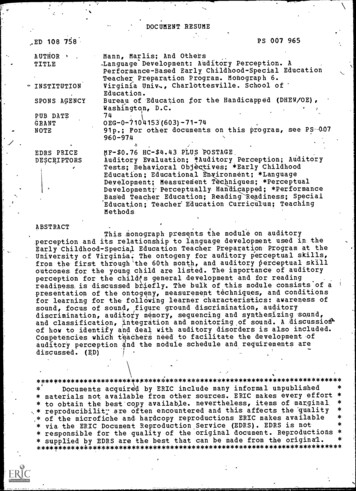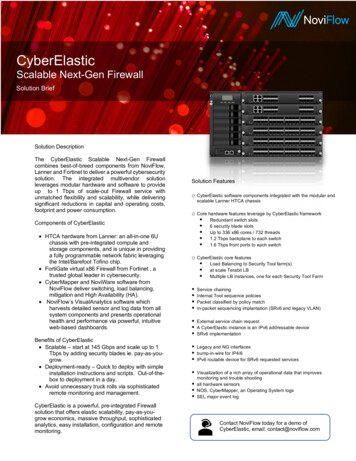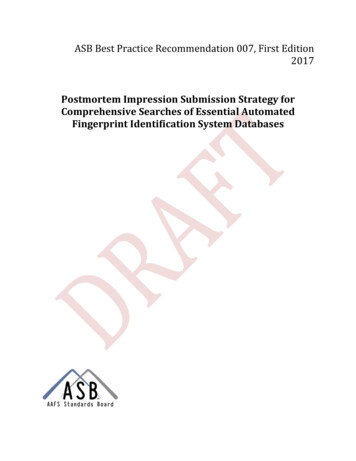
Transcription
ASB Best Practice Recommendation 007, First Edition2017Postmortem Impression Submission Strategy forComprehensive Searches of Essential AutomatedFingerprint Identification System Databases
ASB Best Practice Recommendation 007, 1st Ed. ‐ 2017Postmortem Impression Submission Strategy for ComprehensiveSearches of Essential Automated Fingerprint Identification SystemDatabasesASB Approved Xxxxx 2017Academy Standards Board4200 Wisconsin Avenue, NWSuite 106‐310Washington, DC 20016‐2143This document may be downloaded for free at: http://asb.aafs.org/This document is copyrighted by the AAFS Standards Board, LLC. All rights are reserved.4200 Wisconsin Avenue, NW, Suite 106‐310, Washington, DC 20016‐2143, asb.aafs.org.This document is provided by the AAFS Standards Board for free. You are permitted to print anddownload the document and extracts from the document for your own use, provided that: you do not modify this document or its related graphics in any way; you do not use any illustrations or any graphics separately from any accompanying text; and, you include an acknowledgement alongside the copied material noting the AAFS Standards Boardas the copyright holder and publisher.You expressly agree not to reproduce, duplicate, copy, sell, resell, or exploit for any commercialpurposes, this document or any portion of it. You may create a hyperlink to http://asb.aafs.org toallow persons to download their individual, free copy of this document. Your hyperlink must notportray AAFS, the AAFS Standards Board, this document, our agents, associates and affiliates in anoffensive manner, or be misleading or false. You may not use our trademarks as part of your linkwithout our written agreement for you to do so.The AAFS Standards Board retains the sole right to submit this document to any other forum for anypurpose.Certain commercial entities, equipment or materials may be identified in this document to describe aprocedure or concept adequately. Such identification is not intended to imply recommendations orendorsement by the AAFS or the AAFS Standards Board, nor is it intended to imply that the entities,materials, or equipment are necessarily the best available for the purpose.
ASB Best Practice Recommendation 007, 1st Ed. ‐ 2017ForewordFriction ridge analysis (to include fingerprints, palm prints, and footprints) is a reliable, rapid, andcost‐effective means to identify unknown deceased individuals [1]. The use of postmortemimpressions to rapidly identify decedents centers on the use of Automated FingerprintIdentification System (AFIS) technology. It is essential that law enforcement agencies as well as themedicolegal community understand current fingerprint technology and leverage resources toensure postmortem impressions are appropriately searched through AFIS fingerprint databases foridentification purposes. The medicolegal authority should adhere to the best practices identified inthis text to the extent possible, practical, and appropriate. In the absence of specific guidance, theprinciple, spirit, and intent of this document should be met.These best practices are based upon documentation originally produced by the Scientific WorkingGroup on Disaster Victim Identification and updated by the Organization of Scientific AreaCommittees (OSAC) Subcommittee on Disaster Victim Identification. OSAC submitted a draft to theASB Disaster Victim Identification Consensus Body, which used it as a base for these published BestPractice Recommendations. The final document was produced using the consensus process of theASB, which is an ANSI accredited Standards Developing Organization.All hyperlinks and links are valid and operational at the time of publication of this document.Keywords: forensic identification, postmortem identification, automated fingerprint identificationsystem (AFIS), postmortem fingerprint, disaster victim identification, fingerprint submission strategy,mass fatality, friction ridgeAbstract: The purpose of this document is to provide guidance regarding the submission ofrecorded postmortem impressions for comprehensive searches of essential automated fingerprintidentification system databases. While a number of factors affect the successful search of afingerprint through an automated fingerprint system, one of the most important factors is ensuringthe fingerprint is searched through appropriate antemortem fingerprint databases.
ASB Best Practice Recommendation 007, 1st Ed. ‐ 2017AcknowledgementsASB Contributors:Heather Wigington, Fort Worth Police DepartmentMarzena (Mary‐Ann) Mulawka, John Jay College of Criminal JusticeBryan Johnson, Federal Bureau of InvestigationElias Kontanis, National Transportation Safety BoardJason Wiersema, Harris County Institute of Forensic SciencesOSAC Contributors:Aaron Uhle, Federal Bureau of InvestigationSWGDVI Contributors:Aaron Uhle, Federal Bureau of InvestigationMarzena (Mary‐Ann) Mulawka, New York City ‐ Office of Chief Medical ExaminerHeather Wigington, DHS Biometrics Support CenterMichelle Howard, Federal Bureau of InvestigationJeffrey Carlyle, Federal Bureau of InvestigationDavid Charlton, Sussex Police ‐ United KingdomKimberly Sheets, Federal Bureau of Investigation
ASB Best Practice Recommendation 007, 1st Ed. ‐ 2017Table of Contents1Scope .2Normative References .3Terms and Definitions .4 Recommendations for Searching Records .4.1 General .4.2 Preliminary Information.4.3 Postmortem Fingerprint Recovery Process .4.4 Submission of Postmortem Impressions for Automated Searching .4.5 Automated Searching of Postmortem Impressions.Annex A (informative) Foundational Principals.Annex B (informative) Fingerprint Submission Template – AFIS Database Search.Annex C (informative) Bibliography .Figure 1—Postmortem Fingerprint Submission Strategy.Table B.1—Fingerprint Submission Template .
ASB Best Practice Recommendation 007, 1st Ed. ‐ 2017Postmortem Impression Submission Strategy for Comprehensive Searches ofEssential Automated Fingerprint Identification System Databases1. ScopeThe purpose of this document is to provide guidance regarding the submission of recordedpostmortem impressions for comprehensive searches of essential automated fingerprintidentification system databases. While a number of factors affect the successful search of afingerprint through an automated fingerprint system, one of the most important factors is ensuringthe fingerprint is searched through appropriate antemortem fingerprint databases.2. Normative ReferencesThere are no normative reference documents, Annex C, Bibliography, contains informativereferences.3. Terms and DefinitionsFor purposes of this document, the following definitions apply.3.1.Automated Fingerprint Identification SystemAFISBiometric computer system that allows forensic examiners to encode, digitize, and searchrecovered fingerprint impressions against fingerprint record databases for identification purposes.3.2.friction ridge analysisFingerprints, palm prints, and footprints have friction ridge skin that has been used for personalidentification purposes for well over a century. Collectively, the analysis of prints from any of theseareas of skin is known as friction ridge analysis.3.3.Next Generation IdentificationNGIA biometric repository managed and operated by the Federal Bureau of Investigation (FBI)Criminal Justice Information Services Division (CJIS) that enhances identification services byproviding an incremental replacement of the former system, the Integrated Automated FingerprintIdentification System (IAFIS). Considered one of the largest biometric databases in the world, NGIstores individual fingerprint records and other biometric data for criminal and civil matters.Advanced identification technology provides rapid, efficient, and accurate fingerprint processing.3.4.Automated Biometric Identification SystemIDENTThe Automated Biometric Identification System (IDENT) is the central Department of HomelandSecurity (DHS)‐wide system for storage and processing of biometric and associated biographicinformation for national security; law enforcement; immigration and border management;intelligence; background investigations for national security positions and certain positions ofpublic trust. The IDENT database is considered another one of the largest biometric databases.1
ASB Best Practice Recommendation 007, 1st Ed. ‐ 20173.5.antemortem and postmortem recordsAntemortem (AM) records are records collected from live subjects, and can come from any part offriction ridge skin. Friction ridge skin is present on the palmar and plantar surfaces of the handsand feet. As such, impressions from the fingers and palms of the hands as well as the toes and solesof the feet can all be used for personal identification purposes. During antemortem fingerprintrecovery, the living subject is usually manipulated against the recording medium. Postmortem(PM) records are records collected from deceased subjects. During postmortem fingerprintrecovery, the recording medium is usually manipulated against the deceased subject in the samemanner as the antemortem records. Unless a manual comparison is available, an AFIS search of anunidentified postmortem fingerprint record is used as a tool to find antemortem fingerprint recordsin order to establish or verify the deceased subject’s identity [1,2,3].3.6.10‐print searches and latent print searchesA 10‐print search is conducted on a fingerprint record which is a reproduction of all ten fingers. Anautomated 10‐print inquiry normally requires a minutiae search of only the thumbs or indexfingers. Submitted fingerprints commonly have sufficient clarity and detail to make searching ofmore than two fingers unnecessary. This can be performed by a computer, in a “lights out” setting ifthe quality of the record is high enough.A latent print search can be utilized for searching unknown deceased records when multiple fingersare not printable or present, or the quality of the recordings is poor. A latent print search is moretedious and time‐consuming than a 10‐print search. Latent prints are often fragmentary and of poorimage quality. Minutiae features are normally reviewed one‐by‐one by a trained fingerprintexaminer before the search begins, but can yield in better results with lower quality recordings.Each list of results returned must be manually compared by an examiner to determine if there is amatch [4].4. Recommendations for Searching Records4.1. GeneralCurrent AFIS databases used by law enforcement agencies tasked with forensic identification existat local, state, and federal levels of government. Unlike what may be portrayed in the movies or ontelevision, a single comprehensive and searchable database of AM fingerprint records collected inthe United States or abroad does not exist. Due to data sharing agreements, privacy concernsassociated with personally identifiable information (PII), and system interoperability difficulties,AM records contained within various AFIS databases are not congruent. The individual ororganization submitting PM impressions for fingerprint analysis should ensure that local, state, andfederal AFIS databases are appropriately searched for identification purposes. The effective use ofAFIS technology in searching PM of impressions against AM records can result in a significantincrease in the identification of decedents, allowing the medicolegal community to expedite regularcasework, solve cold cases, and efficiently identify human remains in mass fatality incidents(MFI) [5].2
ASB Best Practice Recommendation 007, 1st Ed. ‐ 20174.2. Preliminary InformationBefore examining the remains, it is advised that fingerprint examiners should familiarizethemselves about the incident. This information may consist of the following. Geographic location – where the remains were recovered. Circumstances surrounding the death (e.g. natural versus accidental versus man‐made event). Circumstances surrounding the recovery of the remains (e.g. found under rubble, recoveredfrom water, remains removal facilitated by implements, or machinery, etc.). Details regarding any identifying documents or personal effects found on the remains and ifthese items have been removed from the remains prior to arrival of the remains at the morgue.Separation of identifying documents or personal effects from the remains prior to examinationshould be avoided whenever possible. Determine if there are AM records available elsewhere, such as decedent’s residence, place ofemployment, etc.4.3. Postmortem Fingerprint Recovery ProcessExamination quality PM fingerprint records should be recorded from human remains using PMfingerprint recovery techniques. Remains should be thoroughly examined as soon as possible,before ongoing decomposition deteriorates the friction ridge skin and limits the ability to recoverquality PM impressions. (1) It is assumed that the remains have been rendered safe from anyhazards and that appropriate personal protective equipment (PPE) is worn. (2) Trained fingerprintexaminers 1 should be utilized for the recovery of examination quality PM impressions from thedeceased and for the subsequent search/submission of recovered fingerprint records throughappropriate AFIS databases.4.4. Submission of Postmortem Impressions for Automated SearchingOnce examination‐quality PM fingerprint impressions are recorded, the submitting agency shouldutilize Annex B, Fingerprint Submission Template – AFIS Database Search (or fields and informationcontained within the template) to send PM impressions to law enforcement or appropriateauthorities for AFIS database searches 2. A PM submission should request an automated 10‐printsearch as well as a latent print search. It is the responsibility of the submitting agency to ensurethat this has taken place. Images uploaded or emailed directly to CJIS Special Processing Center(SPC) or DHS’s BSC must meet the requirements of submission to that agency. While facsimiles areaccepted by some agencies, the low quality transmission can degrade an image enough that it maynot be identified through an AFIS search. Unless it is urgent, if a flatbed scanner or digital camera isunavailable, the cards should be submitted as originals to the respective agencies.The term trained fingerprint examiners indicates that individuals recording or approving the fingerprintrecords must be able to discern the fingerprints’ value for comparison purposes as a quality measure. Thisterm does not encompass/include the training recommended for PM fingerprint recovery techniques.1If a fingerprint record is submitted directly through an established electronic portal, it should conform tothe ANSI/NIST‐ITL standard and the relevant application profile, such as the FBI's EBTS file format.23
ASB Best Practice Recommendation 007, 1st Ed. ‐ 2017 All bold/italicized fields in the attached submission template should be populated bysubmitting agency. All [bracketed] items are specific to each case being submittedfingerprint analysis. Include any possible known demographic information regardingdecedent or fingerprint recording anomalies3 in the additional information section oftemplate.theforthethe Complete the submission template and copy/paste into a secure email service/format (such asLaw Enforcement Online https://www.leo.gov). Recovered PM impressions should be attachedas a digital image and need to be scanned at a minimum resolution of 500ppi. The image mustalso be saved in a lossless format (i.e. JPEG2000 or TIFF). If poor quality fingerprints werereceived, the submitting agency may be contacted by the recipient to rescan prints at aresolution of 1000ppi. The submission template and recovered PM impressions may also be mailed as a hard copy tothe appropriate authorities if electronic submission attempts fail or prove burdensome inaccordance with the procedures and requirements of the receiving agency. If a card is deemedto be bio‐hazardous, ensure the agency you are submitting it to can receive it.4.5. Automated Searching of Postmortem ImpressionsIt is recommended that recorded PM impressions should be submitted for AFIS database searchesin the following order: local, state, federal, international (if remains are believed to have international nexus).It is the responsibility of the submitting agency to ensure that all of these steps are accomplished intheir entirety.a. local authorities should have the capability of electronically submitting the PM impressionsto their local and state AFIS fingerprint databases. It is the responsibility of the submittingagency to ensure that this has taken place. If not, the PM impressions should be forwardedto local and state authorities separately by the submitting agency.b. local authorities may also have the capability of electronically submitting the PM impressions tothe FBI. If not, the PM impressions should be electronically submitted (emailed or uploaded,not faxed) or manually submitted to the FBI CJIS SPC for search through the NGI fingerprintdatabase. CJIS information provided on the following page:FBI CJIS DivisionSpecial Processing Center1000 Custer Hollow Road24/7 Voice Number: (304) 625‐558424/7 Fax Number: (304) 625‐5587Email: spc@leo.gov3PM changes, missing or damaged digits, special reconditioning techniques, case circumstances, etc.4
ASB Best Practice Recommendation 007, 1st Ed. ‐ 2017NOTE: The original submitting agency is only allowed to submit the postmortem impressions to the CJIS SPCif they have a valid Originating Agency Identification (ORI) Number assigned by the FBI per 28 CFR, § 20.3.Medical Examiner/Coroner agencies may request an ORI number (9 character identifier) from the FBI CJISDivision by calling (304) 625‐3984.c. If no match is made in the NGI database, the PM impressions should be electronically (emailedor uploaded, not faxed) submitted to the DHS Biometric Support Center for search through theDHS Automated Biometric Identification System (IDENT) AFIS fingerprint database. DHSinformation provided below:DHSBiometric Support Center – West24/7 Voice Number: (858) 609‐260924/7 Fax: (858) 609‐2600Email: afis@dhs.gov or lpu@dhs.gov If no matches are made on the federal level, it may be valuable to have local or state lawenforcement reach out to neighboring states for assistance in searching the recovered PMimpressions through neighboring l
portray AAFS, the AAFS Standards Board, this document, our agents, associates and affiliates in an . Abstract: The purpose of this document is to provide guidance regarding the submission of . 4.4. Submission

